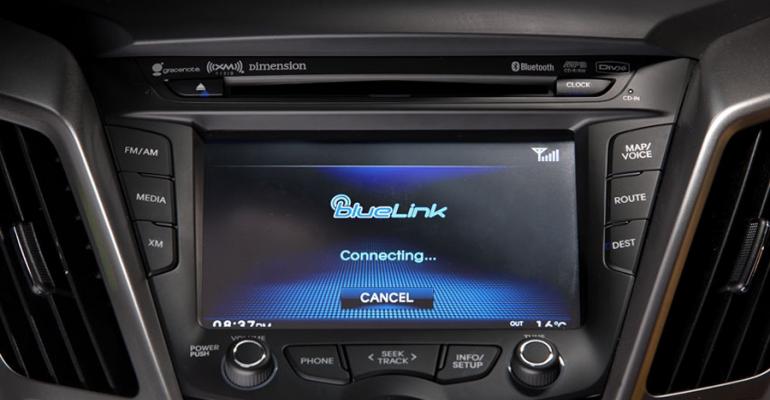CHULA VISTA, CA – Hyundai says that through mid-July nearly 200,000 customers have enrolled in its BlueLink telematics system, which was introduced to the U.S. market just one year ago.
“Our dealers are very engaged, and our enrollment numbers are exceeding our objectives,” Larry Perrault, program manager for the first-generation BlueLink system, says at a Veloster Turbo media event here.
But not all enrollments, which include customers receiving a free trial and those who have a paid yearly subscription, use their system.
Through mid-June, Perrault says Hyundai counted roughly 125,000 active users of BlueLink, a suite of onboard and cloud-based technologies that rely on voice commands to access information and connect users to a call center.
The majority use BlueLink in their car to get directions, he says. However, Hyundai is seeing a “good breadth of usage” of its remote features, such as those found on its Android- and iPhone-compatible mobile applications.
The second version of the BlueLink smartphone app launched in May, and Perrault says the new vehicle remote-start feature is proving popular.
In the first month of its availability, “remote-start usage just skyrocketed,” he says, noting the feature in its first four weeks was used two to three times more than remote lock and unlock.
Point-of-interest searches, supported by Microsoft’s Bing search engine, also are proving popular with subscribers. Hyundai will make it easier to search for airport codes and landmarks with its planned late July tweaking of the telematics system.
“We’re in the process of making manual changes to that search logic,” for better search optimization, Perrault says.
The removal of some confirmation steps in the menu selection was debated, as some users said they found being asked if their selections were correct cumbersome. “We thought maybe people were going to need that,” Perrault says.
A Hyundai spokesman tells WardsAuto the confirmation steps will remain in place for now for accuracy’s sake.
However, the “calls may be recorded” message that BlueLink users encounter when phoning the call center, operated by Agero of Medford, MA, will be changed and moved to the car’s onboard system, which will lessen connection times.
“From the time you push the button to the time you can say a command, (we’ll be) reducing between 6-10 seconds,” Perrault says.
Hyundai is holding the line on BlueLink pricing for ’13, with the Assurance subscription package, featuring automatic collision notification and a monthly vehicle report, still $79 a year. The Essentials package, which adds stolen-vehicle recovery notification, curfew alert and vehicle immobilization, is $179 annually.
The premium Guidance package, which adds turn-by-turn navigation, point-of-interest search and restaurant ratings, is $279 annually.
About half of Hyundai’s models now offer BlueLink, including the Sonata, Veloster, Elantra GT, Azera and Genesis Coupe. The telematics system next will be launched in the ’13 Santa Fe cross/utility vehicle, on sale in late summer/early fall, and is slated for the ’13 Genesis sedan.
Hyundai says BlueLink subscribers range from owners of the new Azera, among its most expensive cars, to buyers of the Veloster, one of the brand’s lower-priced offerings.
“(The) Veloster was having a tendency for a higher enrollment and renewal vs. (the) Sonata,” Perrault says. He suspects Veloster owners, who tend to be young, are opting for BlueLink because they have a better understanding of and comfort level with the technology.
For customers who have canceled BlueLink or failed to subscribe after the free-trial period, which ranges from three to six months, Hyundai surveys show non-use of the system as the top reason for cancellation, with cost about halfway down the list.
Some telematics systems, such as Toyota’s Entune, rely on the user’s smartphone to function, but Perrault believes embedded systems like BlueLink are more reliable, at least when it comes to safety.
“We won’t be departing from embedded,” he says. “We’ve seen testimonials where customers (after an accident) can’t find their phone. They’re talking to us through our agents and they’re a little disoriented. I think some level of embedded services is necessary and what’s right for the customer.”




